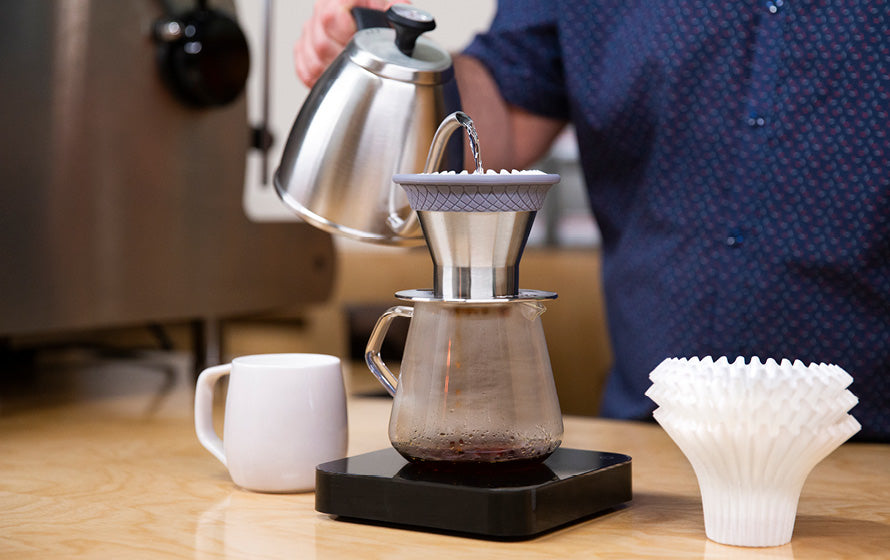There are dozens of types of coffee makers in the world, none have inspired such confusion as drip coffee pots and pour over coffee makers. They seem to work the same way—so why do pour overs even exist?
Why go through all the work when you could have an automatic coffee maker do it for you? Are pour overs just the coffee snob’s way of making things more complicated? Is there really a difference at all?
Contrary to popular belief, pour over coffee is quite different from drip coffee, but the reasons why aren’t very obvious at first glance.
We’ll show you what these differences are, and what they mean, like…
- Why pour over coffee has the potential to taste much better
- How manual brewing =/= hard to learn
- Why automated brewers will never make manual pour overs obsolete
By the end, you’ll know why a pour over costs more at your local cafe than a cup of drip coffee—and you may even want to try pour over coffee at home yourself!
How Drip Coffee Pots Work (Or, Don’t Work)
Auto drip coffee pots are simple machines: they heat water and drip it over coffee grounds. Gravity then takes over and pulls the water through the grounds, out the bottom of the cone, and into the carafe below—voila, coffee!
Simple, right?
Unfortunately, it’s what you can’t do that can become a problem.
Most drip coffee pots have a single preset recipe they’re designed to follow. Sometimes there are 2-3 buttons that will adjust the recipe slightly, but for the most part, whatever the machine is pre-programmed to do, you’re stuck with it.
And there are often a few things you don’t want to be stuck with:
- Low-temperature water. Lower-priced drip coffee pots don’t have the same safety features as higher-end pots, and they’re typically made from plastic. So instead of getting the water temperature up to the recommended ~200 degrees Fahrenheit, which could damage the brewer, the water is only heated up to ~190 degrees, which often leads to sour coffee.
- Inconsistent water pouring. Drip pots have spouts that disperse the hot water over the grounds. Unfortunately, most of these spouts cause some coffee grounds to be really saturated, while others are kept fairly dry. This is, of course, an issue for balanced flavor.
This isn’t always a problem. Many people make great coffee from drip pots without problem. But for coffee lovers who don’t want to settle for “good enough”, and who want some more control over their coffee’s flavor and quality, this next style of coffee maker is probably a better fit.
How Pour Over Coffee Works
Pour over coffee brewing involves pouring hot water over coffee grounds. Gravity then takes over, draining the water through the grounds, out the bottom of the cone, and into your mug—voila, coffee!
Wait! Isn’t that the same thing as drip coffee?
Not quite. Pour over coffee is a fundamentally manual process—there’s no automation involved—and this shift in technique changes how the brewing works.
- You heat the water in a separate kettle. If you want your water at peak brewing temperature (205 degrees), you can do that. If you like a slightly cooler brewing water at 195 degrees, it’s up to you!
- You control the water pouring speed and placement. You have complete control over where you pour water, which means you can more easily ensure all the grounds are evenly saturated. You can also change the speed of your pour as needed to ensure the grounds have just the right amount of time to brew.
That’s really the key difference here: control. But does it really make that much of a difference?
There’s a reason pour over coffee has exploded in popularity in recent years—and it’s not because people are trying to make their lives more complicated. When you taste the difference, you'll see why. Your taste buds will make sure of it!
|
We created the ESPRO Bloom Pour Over Coffee Brewer with a unique design that captures the benefits of manually-brewed coffee without requiring you to get the technique just right. It’s the perfect way to explore the delicious world of pour over coffee—see how it works. |
Let’s Compare: Pour Over vs Drip Coffee
Now that you know how pour over and drip coffee pots work, and the key things that set them apart, let’s see what those differences really mean for your daily brew.
Flavor Quality
When you’re comparing flavor with pour over vs drip coffee pots, there are no hard and fast rules. A drip coffee can beat a pour over coffee, especially if you’re using a higher-end brewer that offers more recipe customization.
However, most coffee lovers who try pour over agree that there’s some magic about the way it’s made that produces a richer, more complex flavor—and we agree.
Read: Coffee Flavor 101: How to Taste Your Brew Like the Pros for Max Enjoyment
Drip coffee pots have a way of mellowing out a coffee’s most interesting flavors. Pour over brewers seem to highlight them. And there’s a good reason.
When you brew pour over coffee, there’s nothing holding you back from achieving an exceptional brew.
- No water temperature limitation
- No recipe you’re stuck with
- No set-in-stone water pouring technique that’s unchangeable
As a result, most people find it easy to brew coffee that’s more nuanced and delicious with a pour over brewer than a drip coffee pot.
Of course, people can also make not-so-good coffee with pour over brewers. Since it’s a fully-manual brewer type, there’s room for error, which brings us to our next comparison…
Simplicity and Ease
Just because you can make better-tasting coffee, doesn’t mean you always will.
The strength of a drip coffee pot is precisely that it always does the same thing, over and over again (for better or for worse). Usually, that means you can count on “good enough I guess” coffee every morning, pretty much without fail.
Pour over brewing, since it’s fundamentally a manual process, means you have to be mindful of your technique when you brew to create those A+ flavors.
This means, of course, that it’s a little less easy. The process is straightforward and simple, but if you lose focus mid-brew when you pour water, you might end up not saturating all the grounds evenly (like a low-end drip pot, or worse).
Making pour over coffee is not hard—far from it—but it’s not automated.
If this concerns you, there’s an easy fix: our ESPRO Bloom Pour Over brewer has special tapered walls that ensure all the coffee is evenly saturated for a balanced brew every time. This resolves some of the inconsistency challenges of older pour over types.
Customizability
Drip pots are straightforward: they make black coffee the way they’re designed to.
Pour over cones are a different story.
- You have power over your brew. If you make a bad cup with a drip pot, well, bummer. That’s just how it is. If you make a not-so-good brew with a pour over, you have the power to make small adjustments to your technique to improve the flavor. For example, fixing sour coffee is pretty easy.
- You can make refreshing iced pour over coffee. This is a huge advantage for many people, especially those living in warm climates. “Flash chilled” coffee is incredibly delicious, and just as flavorful as black pour over coffee—here’s how to make it.
If you just want a daily mug, it’s hard to beat a drip coffee. But if you want more ownership of your coffee, and like to tinker to make things work better and better for you, you’re a shoo-in for loving pour overs instead.
Longevity
To put it plainly, most drip coffee makers are designed to be replaced. The plastic parts don’t last forever, the electronics break down from time to time, and landfills are littered with old pots. Unless you purchase a higher-end model, drip pots generally only last a couple of years.
Pour over brewers, on the other hand, are extremely simple devices, usually just made of one or two metal or ceramic parts. Without wires or breakable electronics, pour over brewers can last and work well for decades.
For this reason, pour over brewers are increasingly popular with not only coffee lovers, but the “Buy It For Life” crowd, who’d rather take life a little slower and produce less landfill waste.
There Are Dozens Of Different Pour Over Coffee Brewers
If you’re looking to give pour over coffee a try, it can seem a little bit daunting at first. There are tons of different types of pour over cones: metal vs ceramic, flat-bottom vs cone-shaped, paper vs metal filters.
Don’t let the brewer diversity scare you away—we have a suggestion that’ll help.
Look for a pour over brewer that’s designed to encourage a balanced extraction.
Most pour overs are made to enable certain types of brewing techniques, but they don’t actually help you brew tastier coffee—you still have to know the right process and technique for that brewer.
That’s why we created the ESPRO Bloom Pour Over Coffee Brewer, a first-of-its-kind brewer that actually produces a more balanced extraction and flavor for you.
You’re still in complete control, but our unique design funnels all the water into the grounds evenly, so if you don’t get the technique just right, you’ll end up with a final mug you’re proud of.
It’s the easiest way to taste the pour over difference—see how it works here.













